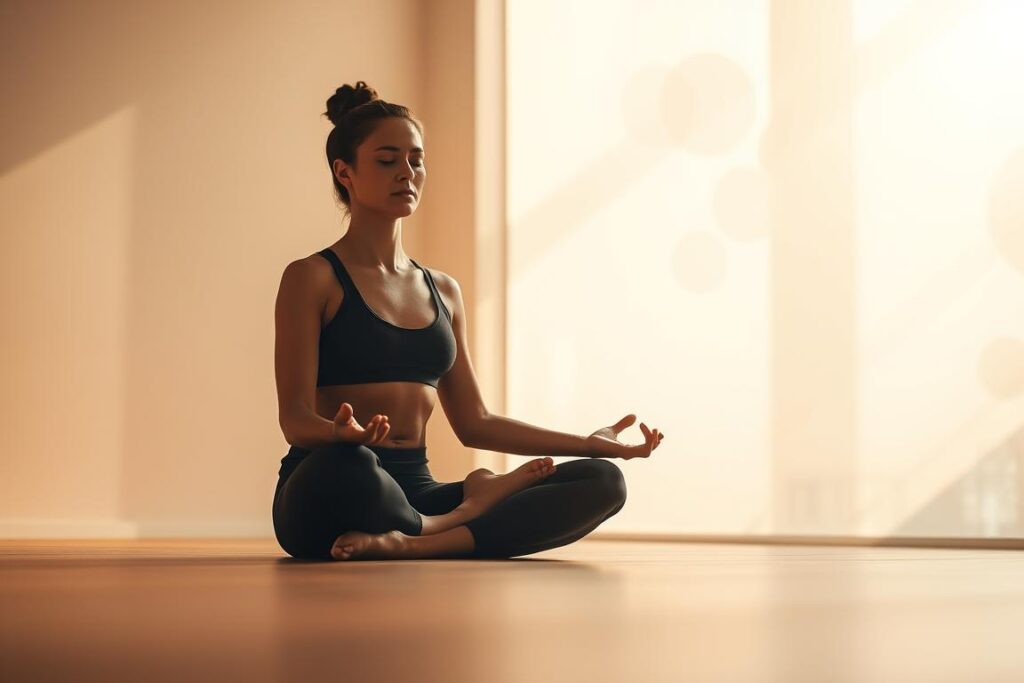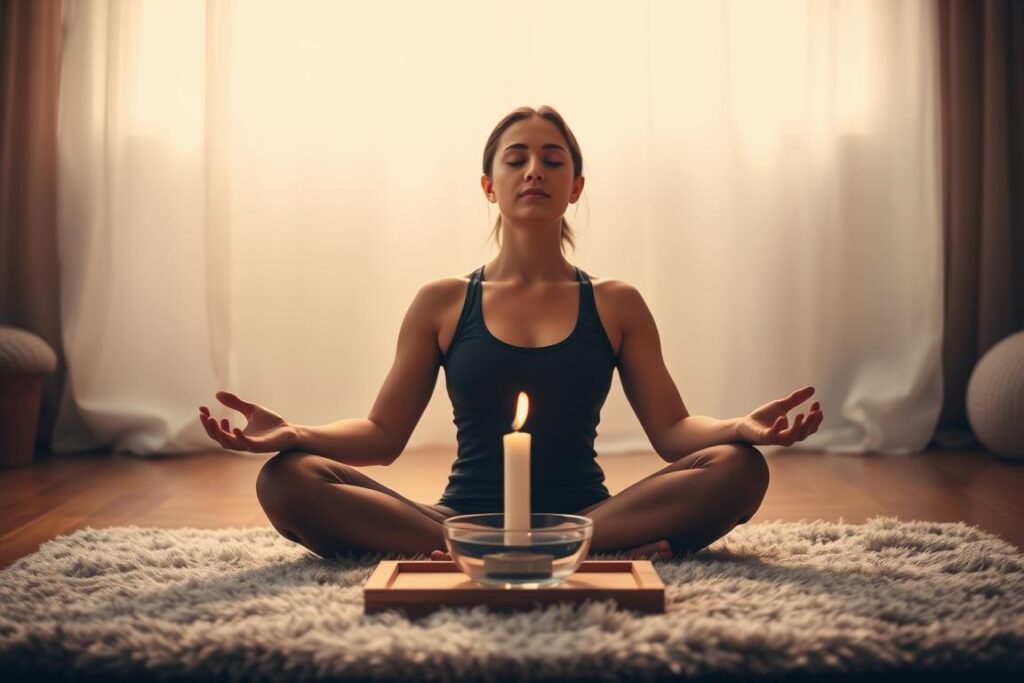
Body Scan Meditation: A Tool for Injury Prevention and Awareness
The phrase body scan meditation for injury prevention may sound clinical, but it can feel like a quiet, practical skill you carry into every workout and daily move.
Start by listening—really listening—to small signals under the skin. Move slowly, name what you sense, and let curiosity replace judgment. That simple attentiveness helps you catch tiny tensions and shift before they grow into bigger problems.
This practice builds reliable awareness that supports smarter movement, faster recovery, and better overall health. It’s rooted in Jon Kabat-Zinn’s MBSR work and used by clinicians like Melissa Young, MD, who teach a gentle, stepwise approach. Research shows clear benefits: reduced stress, improved mood, and measurable gains in physiology across many groups.
Key Takeaways
- You’ll learn a simple, gear-free routine to spot tension early and move smarter.
- Practice trains mindfulness and awareness, helping with stress reduction and recovery.
- Small daily sessions add up—consistency beats perfection.
- Guidance from clinicians and MBSR research backs its practical use.
- Use it in warm-ups, training, cooldowns, or rest to make awareness habitual.
Why body awareness reduces injury risk in the real world
Spotting tiny shifts in how you move helps you make small fixes that matter. A slow, head-to-toe check builds interoceptive awareness so you notice subtle sensations—tight calves, uneven shoulders, or a held breath—before they become pain.
The body-mind connection: noticing early signals before they become pain
Quick checks sharpen your map. When you pay attention, your brain gets clearer data about the parts of the body you use in motion. That lets you change form, shift load, or tweak stance sooner.
- You catch small issues early—so small fixes keep stress off joints and soft tissue.
- A 30–60 second focus reset restores alignment and breath when you’re distracted.
- Regular practice trains the mind and brain to respond with less effort over time.
The main benefit is practical: less time sidelined and more steady improvement. For people juggling work and family, quick check-ins offer real stress reduction and better decision-making mid-session.
How to practice a body scan step by step
Start simple: settle, breathe, and then move your attention through each area to gather useful data.
Set up: Get comfortable sitting upright or lying down. Support your head or knees if that helps. Soften your gaze or close eyes to reduce visual noise.
Head-to-toe sequence
Take three to five slow breaths — inhale through the nose, exhale through the mouth — to calm your nervous system.
Begin at the head. Notice jaw, temples, scalp, and eyes. Name what you feel: tension, heat, pulsing, or nothing.
Move to shoulders and upper back. Check the arms and hands next. Sense weight, temperature, or tingling.
Shift attention to the chest and belly. Track breath and any fullness or fluttering. Then scan the pelvis and hips.
Finish with legs and feet. Notice contact with the floor or mat and any shifting weight.
Name sensations without judging them
If a spot feels blank, say “nothing.” That’s useful data too. Stay curious. Don’t try to change anything; just observe.
Close gently
Widen attention to the whole body for a few breaths. Take one easy breath, open your eyes slowly, and return to the moment.
- Start with 5–10 seconds per area; build to 20–30 seconds.
- If your mind wanders, label “thinking” and bring attention back.
- Use this short scan meditation before or after activity to check for tight spots or asymmetry.
Body scan meditation for injury prevention
Make a ninety-second warm-up habit and you’ll spot tight spots early. A short check before you move saves time off the sidelines and helps you train smarter.
Before activity: quick warm-up check
Do a 90-second warm-up sweep to flag tension in calves, hamstrings, shoulders, or back. If a spot feels tight or uneven, swap in mobility drills or lighter sets. Small swaps early change outcomes.
During training: micro-checks between sets
Use one slow breath between sets to check grip, spine, hips, and feet. Adjust stance or tempo if alignment feels off. These micro-pauses keep form clean and lower strain risk.
After workouts and on rest days
Spend two minutes after a session scanning from legs to head while you walk or lie down. Let muscles soften on the exhale to speed recovery. On rest days, add a short pre-sleep sweep to reduce stress and aid repair.
- Rule of two: if the same pain signal shows up twice, scale load or range; don’t change anything by forcing through sharp discomfort.
- When focus slips, pause for one breath and a quick awareness reset. That present moment check often prevents an unwanted setback.
- Short and simple wins. Pick one area each session—shoulders or hips—and track trends over time.
The science behind scanning: stress reduction, pain modulation, and nervous system training
Over time, gentle awareness practice nudges your physiology away from constant arousal and toward calm. That shift matters. It changes how you feel during training and how fast you recover afterward.

From fight-or-flight to rest-and-digest: how practice trains your nervous system
Regular short sessions move the nervous system toward parasympathetic activity. That means lower baseline stress and less bracing in muscles.
Evidence from mindfulness-based stress reduction: anxiety, depression, and pain outcomes
Research on MBSR shows steady reduction in anxiety and depression across many groups (Greeson 2015; Fogarty 2019; Takahashi 2019). Studies also report better cortisol rhythms and quality of life in chronic illness (Ho 2020; Hecht 2018; Speca 2000).
Why judgment-free attention improves interoception and movement quality
Judgment-free awareness gives clearer signals about tightness and asymmetry. The brain learns what you repeat, so short daily checks produce automatic regulation that helps technique and reduces perceived pain.
- Lower stress supports steadier energy and cleaner movement.
- Meditation and mindfulness produce measurable reduction in pain reactivity.
- Practical benefit: less downtime, smarter load choices, better long-term health.
Safety first: adaptations, edge cases, and when to get help
Safety starts with small adjustments and a clear plan when awareness brings up big feelings. Increased awareness can surface anxiety or intense memories. That is normal, not a failure.
If strong emotion appears: open your eyes, feel the contact of your hands on your thighs, and shorten the practice to one or two regions. These quick steps reduce overwhelm and lower immediate stress.
If intense emotions arise: grounding strategies and working with a qualified therapist
Keep your mind anchored in the present moment by noticing room temperature or a sound nearby before you go inward. You can bring attention to neutral zones like hands or feet first. That often calms reactivity.
Sit up instead of lying down if rumination or drowsiness increases. Gentle movement between sections—shoulder rolls or a short walk—helps too.
- Skip regions that feel overwhelming; self-care wins over rigid rules.
- If anxiety spikes or memories surface, shorten the session and use external cues.
- When stress stays high or daily health worsens, seek a qualified therapist familiar with trauma-informed approaches.
| Sign | Adaptation | Action |
|---|---|---|
| Racing thoughts | Shorten time | Open eyes, touch thighs |
| Tight chest | Neutral zones first | Bring attention to feet |
| Flashbacks | Sit upright | Contact a therapist |
Be honest with yourself. If strong feelings persist, therapy can offer tools and safety. Getting help shows care for your long-term health and lets people keep practicing with less risk. The goal is reduction in strain and wiser choices, not forcing discomfort.
Make it a consistent practice without adding stress
Make this easy: short, regular checks will anchor awareness without stealing your day. Pick a clear trigger and treat the practice like a tiny habit that stacks onto what you already do.

Time and frequency: short daily scans vs. longer weekly sessions
On busy days, aim for a 3-minute practice. On calmer days, set aside 10–20 minutes once or twice a week.
Consistency beats marathon sessions. Short daily work builds automaticity. Longer sessions let you try deeper techniques and notice benefits like better breath and less stress.
Tools and cues: guided audio, timers, and pairing with routines
Use guided audio to remove decision fatigue. Set a simple timer so you’re not clock-watching.
- Anchor practice to routines—after your first coffee, before a meeting, or as a cooldown.
- Try a 60-second whole body sweep before a big call and another before a workout.
- Rotate techniques: lying one day, seated the next; guided some days, self-led others.
Breathe low and slow; one steady breath per area keeps pace and supports relaxation. Track small benefits—better focus, smoother reps, easier sleep—to keep motivation alive.
Conclusion
Use a focused sweep as a tiny habit that protects your progress and eases daily strain. A short, steady check trains attention, lowers stress, and helps you catch tension early. Small acts add up.
Keep it simple: soften your gaze or close eyes, take one slow breath, and move attention through head, shoulders, back, arms, legs, and feet. Name sensations without fixing them and let awareness guide smarter choices.
If anxiety appears, shorten the practice, open your eyes, and ground by touching a chair or the floor. Seek therapy when strong feelings persist—this is care, not failure.
Your next step: set a two-minute timer, do a three-area scan, and make one small adjustment before your next session. Repeat often; consistency wins.


